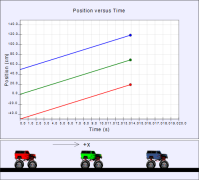
Embed this model in a webpage:
Link to this model:
Link to this model and its source:
Investigate this model further by visiting its Open Source Physics webpage.

In Physlet® Physics One-Dimensional Kinematics Problems we considered motion along a straight line. This motion can be represented in a number of different ways: as a formula, as a graph, as data in a table, or as an animation. All four representations are useful for problem solving. The study of motion in one, two, or three dimensions is called kinematics. What distinguishes kinematics from the techniques which we will consider later is that, at the moment, we do not care why an object is moving the way it is. We just care that it is moving the way described. Do not think that this degrades the study of kinematics. The exact opposite is true. Kinematics is powerful precisely because it is independent of the cause of the motion. We will learn to speak using the common language for describing motion irrespective of the cause.
The problems in this package are based on the One-Dimensional Kinematics Illustrations and test your knowledge of these ideas.
EjsS PhysletsPhyslet® are JavaScript adaptations of PhysletPhyslet® curricular material developed using version 5 of the Easy Java/JavaScript Simulations (EjsS) authoring and modeling tool. The illustrations and problems in these packages are adapted from the Java applet version of Physlet Physics by Wolfgang Christian and Mario Belloni and are available on the Open Source Physics website. The simulations in these package are implemented in JavaScript so that they can run on both desktop computers and mobile devices.
PhysletPhyslet® Illustrations are designed to demonstrate physical concepts. Students need to interact with the Physlet, but the answers to the questions posed in the Illustration are given or are easily determined from interacting with it. Many Illustrations provide examples of physics applications. Other Illustrations are designed to introduce a particular concept or analytical tool. Typical uses of Illustrations would include "reading" assignments prior to class and classroom demonstrations.
PhysletPhyslet® Problems are interactive versions of the kind of exercises typically assigned for homework. They require the students to demonstrate their understanding without as much guidance as is given in the Explorations. They vary widely in difficulty, from exercises appropriate for high school physics students to exercises appropriate for calculus-based university physics students. Some Problems ask conceptual questions, while others require detailed calculations. Typical uses for the Problems would be for homework assignments, in-class concept questions, and group problem-solving sessions.
Additional EjsS models can be found by searching for the expression "JS Models" on the Open Source Physics website.
![]()
PhysletsPhyslet® were developed at Davidson College by Wolfgang Christian.